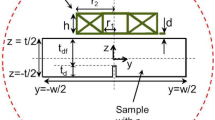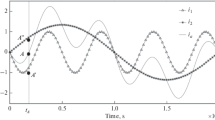Abstract
Novel approach using swept frequency eddy current technique is employed in non-destructive inspection of conductive materials. Possibility of defect extent evaluation from response signals is experimentally studied. Two plate specimens made of austenitic steel SUS 316L containing artificial electro-discharge machined notches are inspected. The notches vary in dimensions, and they are inspected by two eddy current probes. In particular, a length and a depth dimensions of the notches are concerned here. A wide frequency range is used for the experiments, while the probes containing a transmitting and a receiving coils are located at fixed positions over the plates’ surface during entire inspection. The voltage transfer frequency characteristics of the probes are recorded as the response signals. The frequency range is adjusted in such a way that the electrical resonance is clearly visible from the acquired characteristics. Influences of the defects’ length and depth on the response signals are evaluated in order to investigate possibilities of cracks’ evaluation. The presented results clearly show that the resonance frequency depends on a defect extent.














Similar content being viewed by others
References
Pullteap S (2016) Development of an optical fiber-based interferometer for strain measurements in non-destructive application. Electr Eng. doi:10.1007/s00202-016-0435-9
Mertzanides I, Goudos S, Sahalos J (2002) Direct solution and Monte Carlo simulation of the inverse problem in two-layered half-space. Electr Eng. doi:10.1007/s002020100081
Kemppainen M, Virkkunen I (2011) Crack characteristics and their importance to NDE. J Nondestruct Eval 30:143–157
Balageas D, Fritzen CP, Guemes A (2006) Structural health monitoring. ISTE Ltd., London
Jardine AKS, Lin D, Banjevic D (2006) A review on machinery diagnostics and prognostics implementing condition-based maintenance. Mech Syst Signal Process 20:1483–1510
Garia-Martin J, Gomez-Gil J, Vazquez-Sanchez E (2011) Non-destructive techniques based on eddy current testing. Sensors 11:2525–2565
Janousek L, Capova K, Gombarska D, Smetana M (2010) Progress in eddy-current non-destructive evaluation of conductive materials. Acta Technica CSAV 55:13–28
Secue JR, Mombello EE (2014) New SFRA measurement interpretation methodology for the diagnosis of power transformers. Electr Eng. doi:10.1007/s00202-013-0286-6
Tai CC (2000) Characterization of coatings on magnetic metal using the swept-frequency eddy current method. Rev Sci Instrum 71:3161–3167
Mao X, Leib Y (2016) Thickness measurement of metal pipe using swept-frequency eddy current testing. NDT E Int 78:10–19
Strapacova T, Smetana M, Capova K (2014) Material defect identification using sweep frequency eddy current technique. Stud Appl Electromagn Mech Electromagn Nondestruct Eval 39:280–287
Stubendekova A, Janousek L (2015) Non-destructive testing of conductive material by eddy current air probe based on swept frequency. J Electr Eng 66:174–177
Acknowledgements
This work was supported by the Slovak Research and Development Agency under the contract No. APVV-0349-10. The authors wish to thank for the support to the R&D Operational Program Centre of Excellence of Power Electronics Systems and Materials for their components, No. OPVaV-2008/2.1/01-SORO, ITMS 26220120003 funded by European community.
Author information
Authors and Affiliations
Corresponding author
Rights and permissions
About this article
Cite this article
Stubendekova, A., Janousek, L. Impact of defect extent on swept frequency eddy current responses in non-destructive evaluation. Electr Eng 99, 1275–1281 (2017). https://doi.org/10.1007/s00202-017-0650-z
Received:
Accepted:
Published:
Issue Date:
DOI: https://doi.org/10.1007/s00202-017-0650-z




